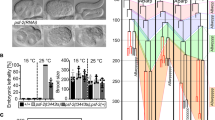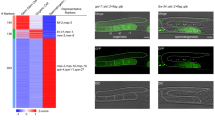Abstract
Most of the 131 cells that die during the development of a Caenorhabditis elegans hermaphrodite do so ∼30 min after being generated. Furthermore, in these cells, the pro-caspase proCED-3 is inherited from progenitors and the transcriptional upregulation of the BH3-only gene egl-1 is thought to be sufficient for apoptosis induction. In contrast, the four CEM neurons, which die in hermaphrodites, but not males, die ∼150 min after being generated. We found that in the CEMs, the transcriptional activation of both the egl-1 and ced-3 gene is necessary for apoptosis induction. In addition, we show that the Bar homeodomain transcription factor CEH-30 represses egl-1 and ced-3 transcription in the CEMs, thereby permitting their survival. Furthermore, we identified three genes, unc-86, lrs-1, and unc-132, which encode a POU homeodomain transcription factor, a leucyl-tRNA synthetase, and a novel protein with limited sequence similarity to the mammalian proto-oncoprotein and kinase PIM-1, respectively, that promote the expression of the ceh-30 gene in the CEMs. On the basis of these results, we propose that egl-1 and ced-3 transcription are coregulated in the CEMs to compensate for limiting proCED-3 levels, which most probably are a result of proCED-3 turn over. Similar coregulatory mechanisms for BH3-only proteins and pro-caspases may function in higher organisms to allow efficient apoptosis induction. Finally, we present evidence that the timing of the death of the CEMs is controlled by TRA-1 Gli, the terminal global regulator of somatic sexual fate in C. elegans.
Similar content being viewed by others
Log in or create a free account to read this content
Gain free access to this article, as well as selected content from this journal and more on nature.com
or
Abbreviations
- CED:
-
cell-death abnormal
- EGL:
-
egg-laying abnormal
- CEM:
-
cephalic companion neurons
- UNC:
-
uncoordinated
References
Conradt B . Genetic control of programmed cell death during animal development. Annu Rev Genet 2009; 43: 493–523.
Horvitz HR . Nobel lecture. Worms, life and death. Biosci Rep 2003; 23: 239–303.
Chen F, Hersh BM, Conradt B, Zhou Z, Riemer D, Gruenbaum Y et al. Translocation of C. elegans CED-4 to nuclear membranes during programmed cell death. Science 2000; 287: 1485–1489.
Maurer CW, Chiorazzi M, Shaham S . Timing of the onset of a developmental cell death is controlled by transcriptional induction of the C. elegans ced-3 caspase-encoding gene. Development 2007; 134: 1357–1368.
Shaham S, Horvitz HR . Developing Caenorhabditis elegans neurons may contain both cell-death protective and killer activities. Genes Dev 1996; 10: 578–591.
Sulston JE, Schierenberg E, White JG, Thomson JN . The embryonic cell lineage of the nematode Caenorhabditis elegans. Dev Biol 1983; 100: 64–119.
Nehme R, Conradt B . egl-1: a key activator of apoptotic cell death in C. elegans. Oncogene 2008; 27 (Suppl 1): S30–S40.
Sulston JE, Horvitz HR . Post-embryonic cell lineages of the nematode, Caenorhabditis elegans. Dev Biol 1977; 56: 110–156.
White JQ, Nicholas TJ, Gritton J, Truong L, Davidson ER, Jorgensen EM . The sensory circuitry for sexual attraction in C. elegans males. Curr Biol 2007; 17: 1847–1857.
Conradt B, Horvitz HR . The C. elegans protein EGL-1 is required for programmed cell death and interacts with the Bcl-2-like protein CED-9. Cell 1998; 93: 519–529.
Ellis HM, Horvitz HR . Genetic control of programmed cell death in the nematode C. elegans. Cell 1986; 44: 817–829.
Wolff JR, Zarkower D . Chapter 1 somatic sexual differentiation in Caenorhabditis elegans. Curr Top Dev Biol 2008; 83: 1–39.
Peden E, Kimberly E, Gengyo-Ando K, Mitani S, Xue D . Control of sex-specific apoptosis in C. elegans by the BarH homeodomain protein CEH-30 and the transcriptional repressor UNC-37/Groucho. Genes Dev 2007; 21: 3195–3207.
Schwartz HT, Horvitz HR . The C. elegans protein CEH-30 protects male-specific neurons from apoptosis independently of the Bcl-2 homolog CED-9. Genes Dev 2007; 21: 3181–3194.
Desai C, Horvitz HR . Caenorhabditis elegans mutants defective in the functioning of the motor neurons responsible for egg laying. Genetics 1989; 121: 703–721.
Doniach T . Activity of the sex-determining gene tra-2 is modulated to allow spermatogenesis in the C. elegans hermaphrodite. Genetics 1986; 114: 53–76.
Jager S, Schwartz HT, Horvitz HR, Conradt B . The Caenorhabditis elegans F-box protein SEL-10 promotes female development and may target FEM-1 and FEM-3 for degradation by the proteasome. Proc Natl Acad Sci USA 2004; 101: 12549–12554.
Finney M, Ruvkun G . The unc-86 gene product couples cell lineage and cell identity in C. elegans. Cell 1990; 63: 895–905.
Finney M, Ruvkun G, Horvitz HR . The C. elegans cell lineage and differentiation gene unc-86 encodes a protein with a homeodomain and extended similarity to transcription factors. Cell 1988; 55: 757–769.
Schimmel P . Development of tRNA synthetases and connection to genetic code and disease. Protein Sci 2008; 17: 1643–1652.
Milchanowski AB, Henkenius AL, Narayanan M, Hartenstein V, Banerjee U . Identification and characterization of genes involved in embryonic crystal cell formation during Drosophila hematopoiesis. Genetics 2004; 168: 325–339.
Nagarajan L, Louie E, Tsujimoto Y, ar-Rushdi A, Huebner K, Croce CM . Localization of the human pim oncogene (PIM) to a region of chromosome 6 involved in translocations in acute leukemias. Proc Natl Acad Sci USA 1986; 83: 2556–2560.
Bischoff M, Schnabel R . A posterior centre establishes and maintains polarity of the Caenorhabditis elegans embryo by a Wnt-dependent relay mechanism. PLoS Biol 2006; 4: e396.
Schnabel R, Hutter H, Moerman D, Schnabel H . Assessing normal embryogenesis in Caenorhabditis elegans using a 4D microscope: variability of development and regional specification. Dev Biol 1997; 184: 234–265.
Thellmann M, Hatzold J, Conradt B . The Snail-like CES-1 protein of C. elegans can block the expression of the BH3-only cell-death activator gene egl-1 by antagonizing the function of bHLH proteins. Development 2003; 130: 4057–4071.
Bachmann M, Moroy T . The serine/threonine kinase Pim-1. Int J Biochem Cell Biol 2005; 37: 726–730.
Klass M, Wolf N, Hirsh D . Development of the male reproductive system and sexual transformation in the nematode Caenorhabditis elegans. Dev Biol 1976; 52: 1–18.
Schafer ZT, Kornbluth S . The apoptosome: physiological, developmental, and pathological modes of regulation. Dev Cell 2006; 10: 549–561.
Kumar S, Cakouros D . Transcriptional control of the core cell-death machinery. Trends Biochem Sci 2004; 29: 193–199.
Brenner S . The genetics of Caenorhabditis elegans. Genetics 1974; 77: 71–94.
Riddle DL . C. elegans II. Cold Spring Harbor Laboratory Press: Cold Spring Harbor, 1997.
Simmer F, Tijsterman M, Parrish S, Koushika SP, Nonet ML, Fire A et al. Loss of the putative RNA-directed RNA polymerase RRF-3 makes C. elegans hypersensitive to RNAi. Curr Biol 2002; 12: 1317–1319.
Grote P, Conradt B . The PLZF-like protein TRA-4 cooperates with the Gli-like transcription factor TRA-1 to promote female development in C. elegans. Dev Cell 2006; 11: 561–573.
Stringham E, Pujol N, Vandekerckhove J, Bogaert T . unc-53 controls longitudinal migration in C. elegans. Development 2002; 129: 3367–3379.
Barr MM, Sternberg PW . A polycystic kidney-disease gene homologue required for male mating behaviour in C. elegans. Nature 1999; 401: 386–389.
Shaham S, Bargmann CI . Control of neuronal subtype identity by the C. elegans ARID protein CFI-1. Genes Dev 2002; 16: 972–983.
Brockie PJ, Madsen DM, Zheng Y, Mellem J, Maricq AV . Differential expression of glutamate receptor subunits in the nervous system of Caenorhabditis elegans and their regulation by the homeodomain protein UNC-42. J Neurosci 2001; 21: 1510–1522.
Timmons L, Court DL, Fire A . Ingestion of bacterially expressed dsRNAs can produce specific and potent genetic interference in Caenorhabditis elegans. Gene 2001; 263: 103–112.
Mello C, Fire A . DNA transformation. Methods Cell Biol 1995; 48: 451–482.
Schnabel R, Bischoff M, Hintze A, Schulz AK, Hejnol A, Meinhardt H et al. Global cell sorting in the C. elegans embryo defines a new mechanism for pattern formation. Dev Biol 2006; 294: 418–431.
Acknowledgements
We thank E. Lambie and S. Rolland for comments on the manuscript; H. Schwartz, M. Saito, J. Dunlap, and members of the Conradt laboratory for discussions; D. Mayka and C. Huber for excellent technical support; E. Lambie for use of the micro-injection set-up; H. Schwartz and B. Horvitz for array nEx1171 (Pceh−30ceh-30::gfp); S. Shaham for array nsEx37 (Pcfi−1gfp) and a ced-3 reporter; N. Pujol for array bgEx21 (Punc−53gfp); V. Maricq for array akEx32 (Pglr−4glr-4::gfp); M. Barr for array syEx301 (Plov−1gfp) and plasmid Ppkd−2gfp; the Sanger Centre (Hinxton, UK) for cosmids; and the C. elegans Genetics Center (CGC, supported by the NIH National Center for Research Resources) for strains. This work was supported by funding from the Max Planck Society, Howard Hughes Medical Institute Award 76200-560801 to Dartmouth Medical School under the Biomedical Research Support Program for Medical Schools, and National Institute of Health grant R01-GM069950.
Author information
Authors and Affiliations
Corresponding author
Ethics declarations
Competing interests
The authors declare no conflict of interest.
Additional information
Edited by M Hengartner
Supplementary Information accompanies the paper on Cell Death and Differentiation website
Supplementary information
Rights and permissions
About this article
Cite this article
Nehme, R., Grote, P., Tomasi, T. et al. Transcriptional upregulation of both egl-1 BH3-only and ced-3 caspase is required for the death of the male-specific CEM neurons. Cell Death Differ 17, 1266–1276 (2010). https://doi.org/10.1038/cdd.2010.3
Received:
Revised:
Accepted:
Published:
Issue date:
DOI: https://doi.org/10.1038/cdd.2010.3
Keywords
This article is cited by
-
EFF-1 fusogen promotes phagosome sealing during cell process clearance in Caenorhabditis elegans
Nature Cell Biology (2018)
-
Cell lineage and cell death: Caenorhabditis elegans and cancer research
Nature Reviews Cancer (2011)



